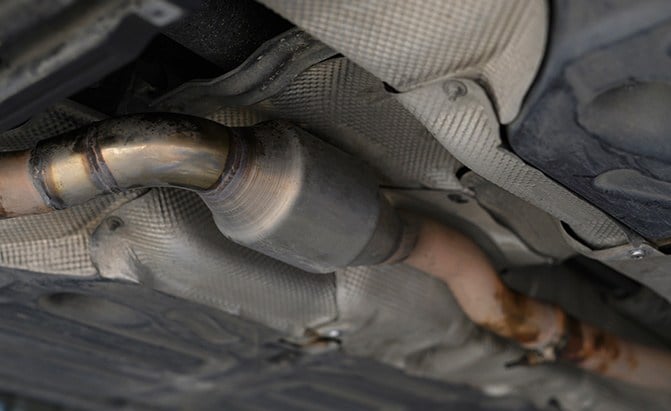The Best Catalytic Converter Cleaners to Help Clean Up Your Ride
Problems with catalytic converters are one of the most common causes of check engine lights, but they’re extremely expensive to replace, so if you’re having issues, it makes sense to try one of the best catalytic converter cleaners first.
You may never think about this component of your vehicle, but the catalytic converter cleans your engine’s exhaust by turning the exhaust gases into other gases that are less harmful to people and the air. It’s a high heat process in the dirtiest part of your vehicle, and that can, over time, cause buildup and even clogging in your catalytic converter, meaning that it does less, well, converting. That could be why you’ve failed a smog test or why that check engine light is on.
There are also usually several O2 sensors in your exhaust system, one of which will be associated with your catalytic converter (or converters, if you have a true dual exhaust). Your converter might be OK, but your O2 sensor can throw a code because of contamination. This is actually the best case scenario for you, because the best catalytic converter cleaners also work on O2 sensors, and they’re much easier to clean.
If you’re using a catalytic converter cleaner to try to pass inspection, you usually have to run through at least a full tank of gas with the additives before a dash light might go out; and three or four tanks isn’t unusual, so try to start early if you can. The code will also be stored in your car’s computer (although you can delete it with an OBDII code reader), and most state inspections require that you drive at least 75 miles with the light off before you can pass.
Whether it’s because of a check engine light that won’t go away, or a failed emissions test on a vehicle that seems otherwise in good condition, rather than spend a load of money on a new catalytic converter, trying to clean the one you have is always worth a go. Since you can’t use a brush to clean out the cat, your best bet is to try and use one of these catalytic converter cleaner additives.
To learn more about the best catalytic converter cleaners, refer to our table of contents.
Table of contents
- 1. Editor's Pick: DuraLube Severe Catalytic and Exhaust Treatment
- 2: Most Heavy-Duty: Liqui Moly Catalytic System Clean
- 3. Cataclean
- 4. Solder-It Catalytic Converter Cleaner
- 5. Autoprofi OXICAT Oxygen Sensor & Catalytic Converter Cleaner
- 6. CRC Guaranteed to Pass Emissions Sensor Cleaner
- Why Do I Need Catalytic Converter Cleaner?
- How Often Should I use a Cleaner?
- Will it Fix my Clogged or Broken Catalytic Converter?
1. Editor's Pick: DuraLube Severe Catalytic and Exhaust Treatment
Dura Lube Severe Catalytic and Exhaust Treatment is designed to help to clean your catalytic exhaust system, meaning that it will remove buildups and contamination that are causing your catalyst to lose efficiency, which can cost you power and money as well as dirtying the air that flows out the back.
It also helps to lower phosphorous and zinc retention at the inlet of the catalyst, both of which can cause premature poisoning and failure of a catalytic converter. This should help clean OBD error code P0420, which is the one that tells you your catalytic converter isn't operating and cleaning as it should. One bottle lasts up to 5,000 miles (or three months), adding one bottle to the fuel tank for up to about 15.9 gallons of gasoline. The product is also safe for engines using diesel and ethanol-containing flex-fuels.
Pros | Requires one application per 5,000 miles, add directly to fuel |
Cons | More expensive than other brands |
2: Most Heavy-Duty: Liqui Moly Catalytic System Clean
Liqui Moly is a respected German brand that develops, tests, and produces their products in-house. The company's Catalytic System Clean doesn't promise to be a miracle cure, but when used correctly, can make a real difference in cleaning catalytic converters and O2 sensors, and may help clear emissions related trouble codes.
This product must be sprayed, using a specific spray bottle, into the intake tract behind the airflow sensor and a turbocharger, if equipped. This may be more than some people are willing to attempt, but it's also why Liqui Moly may work where other, lighter-duty products won't. The pump spray bottle can be reused for a variety of chemical application needs.
The ingredients include c10-C14 hydrocarbons, n-alkanes, isoalkanes, cyclics, and napthalene, which should react with built-up deposits inside the catalytic system and allow them to be removed in the exaust.
Pros | Probably the most effective catalytic converter cleaner on the market |
Cons | Must be sprayed into the intake system while the engine is running |
Cataclean by Mr. Gasket can get rid of carbon buildup in your catalytic converter. That's the type of contamination that can be caused by a poorly running engine (think old spark plugs or a leaky fuel injector), which won't necessarily be removed even when you fix the other problems in your engine. Instead of needing a new cat because your engine ran rich for a while, use Cataclean to help get that carbon out.
It can fix drivability issues, too, because that carbon can choke your converter making it hard for the engine to breathe. Low airflow from clogging increases pollution, hurts power, and ruins fuel economy. Cataclean claims it can lower hydrocarbon emissions up to 50 percent, making your car, truck, or SUV less of a polluter as it ages. This cat cleaner also cleans your fuel injectors and cylinder heads, helping remove power-starving and engine harming buildups in those components as well.
Pros | May help improve engine efficiency and performance |
Cons | Expensive compared to other fuel additives, may not be compatible with all fuel systems |
4. Solder-It Catalytic Converter Cleaner
A failing or poorly-operating catalytic converter can lead to a rotten egg smell in your exhaust. That's related to part of the function of the device, where harmful hydrogen sulfide is turned into sulfur dioxide. This is less important than in the past thanks to low-sulfur fuels, but it hasn't completely disappeared. So if you're getting that rotten egg smell, there's a problem with the cat. Or you need to remove your old lunch.
This fuel additive can help to "scrub" the inside of your catalytic converter, removing the deposits that are preventing it from working correctly. Used as directed, it can also help clean your oxygen sensors, making sure that they're reading correctly as well as extend the time between needed tune-ups. On older engines, you can pour this directly into a running engine's carburetor to let it work even more quickly than it would diluted in a fuel tank.
Pros | May clean O2 sensors, carburetor compatible, 6,000-mile interval |
Cons | May need repeat applications, can damage catalytic converter if used incorrectly |
5. Autoprofi OXICAT Oxygen Sensor & Catalytic Converter Cleaner
German-made OXICAT is added to your fuel, and when burned is circulated through the exhaust system. This helps to remove the buildup of carbon and other contaminants, restoring the performance to O2 sensors and catalytic converters. OXICAT is designed to be used in conjunction with other maintenance procedures such as spark plug replacement and engine tune-ups. It is safe to use with all types of gasoline, diesel and hybrid vehicles.
Pros | Money-back guarantee, easy to use |
Cons | One of the more expensive catalytic converter cleaners |
6. CRC Guaranteed to Pass Emissions Sensor Cleaner
Guaranteed to pass. It's a bold claim, but the manufacturer says that you'll pass your emissions test or get double your money back. That's because it will reduce carbon monoxide, hydrocarbon, and nitrogen oxides emissions. The powerful detergents in the mixture will remove carbon and varnish deposits from the fuel system, allowing everything to run more smoothly and more cleanly than before. The steps are simple, pour a bottle into a tank of gas, run that tank down to close to empty, then fill your tank back up and they guarantee you'll pass.
Of course that guarantee only applies if the rest of your car is running correctly and the engine is stock: it won't fix that broken fuel injector or disconnected oxygen sensor. While it's easy to be skeptical of claims like this, there are plenty of happy reviews from customers with vehicles that were otherwise working well but not passing emissions using the product and coming back to successful results.
Pros | Money-back guarantee, can help with check engine lights from O2 sensor codes |
Cons | Usually requires several tanks of gas to see results, 3,000 mile interval |
Why Do I Need Catalytic Converter Cleaner?
Photo credit: fru-fru / Shutterstock.com
Years of low quality gas, engine problems you waited too long to repair, and general vehicle age can all lead to the deterioration of catalyst efficiency and lead to carbon buildup and clogging inside the complex innards of your catalytic converter. As long as the internal structure hasn't physically broken down, there's a chance that one of these additives can bring it back to proper function. That cleans the air coming out of your exhaust, reducing pollution and keeping toxic materials out of the air you breathe. If that catalytic efficiency check engine code keeps popping up, and it's all alone, a catalyst cleaner is your best place to start before spending thousands to replace that expensive can full of precious metals under your car.
How Often Should I use a Cleaner?
Follow the manufacturer's recommendations, but once per oil change is often enough. On older cars, which produce more emissions than later models, more frequent use may be needed to keep your cat working better down the road.
Will it Fix my Clogged or Broken Catalytic Converter?
If it's completely clogged inside, or, worse yet, the catalyst material has broken down into pieces inside the exhaust (tap it with a soft hammer and listen for internal rattling), then nothing in a bottle can bring it back to life. In that case, you will need to replace your converter, but for smaller issues these cleaners could be wallet saving.
Recent Updates:
December 5, 2022: Added Autoprofi OXICAT to recommendations. Updated photos and product links.
August 23, 2022: Removed Hi-Gear EZ. Added Liqui Moly 8931 Catalytic-System Cleaner.
We are committed to finding, researching, and recommending the best products. We earn commissions from purchases you make using the retail links in our product reviews. Learn more about how this works.
Photo credit: Setta Sornnoi / Shutterstock.com
Evan moved from engineering to automotive journalism 10 years ago (it turns out cars are more interesting than fibreglass pipes), but has been following the auto industry for his entire life. Evan is an award-winning automotive writer and photographer and is the current President of the Automobile Journalists Association of Canada. You'll find him behind his keyboard, behind the wheel, or complaining that tiny sports cars are too small for his XXXL frame.
More by Evan Williams







































Comments
Join the conversation
The YouTube or that says start your engines that I was glasses who lives in Texas said that with around a 1/2 a tank of gas pour in one gallon of lacquer thinner and that will clean your catalytit converter. He is never misled anyone as he is a master mechanic. And reading 50 reviews every single one of them said that fixed their problem. The other method is take the cat off into a bucket or tub of liquid soap And water overnight.
Can a P1151 code indicate bad cat converter? I have changed virtually every ignition component. An egr valve was going to be next. Yesterday I tried a bottle of Rislone Cat Complete Cleaner. I think the Ranger is running better, maybe give the stuff a chance to work?